RBA Annual Conference – 2000 The Australian Economic ‘Miracle’: A View from the North Charles Bean
Abstract
This paper analyses a variety of aspects of the ‘miraculous’ performance of the Australian economy in the 1990s from an international perspective. We start by considering the conduct of macroeconomic policies, arguing that a mixture of good institutional design and wise decision-making has ensured an appropriate macroeconomic stance, particularly through the turbulent period of the Asian Crisis. This has supported good supply-side performance underpinned by labour market institutions that have proved reasonably flexible and robust trend productivity growth. Although cross-country evidence suggests that the information and communications technology revolution does help to explain the recent international behaviour of total factor productivity growth, it seems to play little role in explaining the remarkably good relative productivity performance of the Australian economy which we attribute to the increased competitive pressure stemming from the past removal of tariff barriers and the low level of regulation more generally. However, the increasing level of external debt and the low level of household savings means that the economy remains vulnerable.
1. Introduction
In the last few years plenty of media attention has focused on the miraculous economic performance of the US. Across the other side of the Pacific, however, the performance of the Australian economy has in its own way been equally remarkable, especially since 1997 during which growth has remained buoyant and inflation low despite the Asian Crisis. Unfortunately economic miracles have an unfortunate tendency to turn sour. After all, five years ago people were lauding the economic policies and performance of countries such as Malaysia, whilst fifteen years ago Japan was the miracle economy that the rest of the world aspired to emulate. Can we be sure that the good economic performance of Australia in recent years will be continued? Or will it all end with a nasty hangover?
In this contribution I give an outsider's view of Australia's economic performance during the 1990s, noting some points of similarity, and of contrast, with the rest of the OECD. In particular, since my comparative advantage lies in observing and analysing the British economy, I shall seek to draw some lessons by comparing and contrasting the performance of the Australian economy in the 1990s with that of the UK. For we too have also experienced a period of sustained growth and falling unemployment since early in the decade, although the performance on the productivity front has not been as impressive as Australia's. But the more interesting contrast in many ways is not so much with the UK economy of today, but rather with that of Mrs Thatcher's Britain a decade ago. That too was labelled an economic miracle, and it too was one that turned sour with Britain experiencing its second deepest post-war recession during 1990–92. There are some uncomfortable parallels between the UK at the end of 1980s and Australia at the end of the 1990s, although policy-makers in Australia are in a better position to counteract any downturn than were their British counterparts.
The rest of the paper proceeds as follows. In the next section I begin by surveying the main macroeconomic indicators, and then move on to discuss the macroeconomic policy framework. Section 3 examines the behaviour of unemployment in more detail, whilst Section 4 discusses the sources of the acceleration in productivity growth. Finally Section 5 looks at the behaviour of savings and the current account of the balance of payments.
2. Macroeconomic Performance and Policies
The key features of Australia's comparative economic performance are summarised in Figures 1–4. Figure 1 shows the OECD estimate of the level of GDP per head, measured at purchasing power parity exchange rates, together with that of most of the other developed economies. This shows that Australia's relative position in the pecking order had risen from sixteenth at the start of the 1990s to eleventh by the end, by which time living standards were on a par with those of Germany, and well ahead of the UK. However, income per capita is still some 25 per cent lower than in the US which is indicative of the margin for catch-up that still remains.
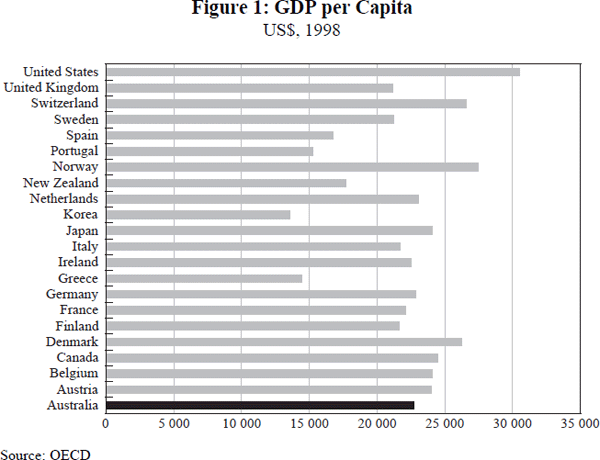
Figures 2–4 show the evolution of the growth rate of GDP, the unemployment rate and the inflation rate, three key indicators for Australia, and for the US, the EU[1] and the UK. Figure 2 shows that since the 1991 trough the growth rate of the Australian economy has consistently exceeded that of both the US and that of the UK, also a good performer over this period. The growth of all three Anglo-Saxon economies comfortably outstrips that of the EU. Associated with this excellent growth performance, unemployment rates have fallen steadily, although from somewhat higher initial levels in the case of Australia and the UK; by contrast unemployment in the EU has stagnated at double-digit levels until only very recently (Figure 3). Despite this contrast between the growth and unemployment performance of the Anglo-Saxon three and that of continental Europe, the inflation performance has been quite similar, with inflation brought down to around 2 per cent in all four regions (Figure 4), betokening improved supply-side performance in the Anglo-Saxon three. As we shall see below, this improved supply-side performance has been associated not only with falling natural, or equilibrium, rates of unemployment, but also with an acceleration in trend total factor productivity growth in Australia and the US, although not the UK.
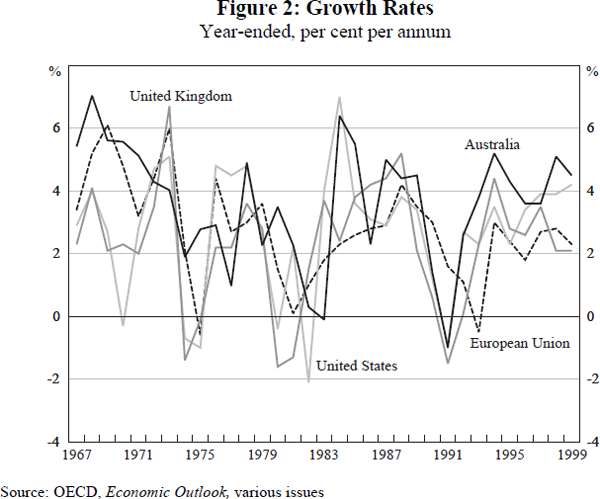
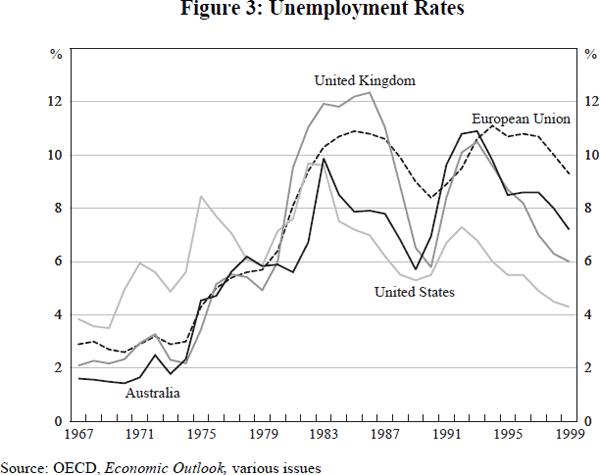
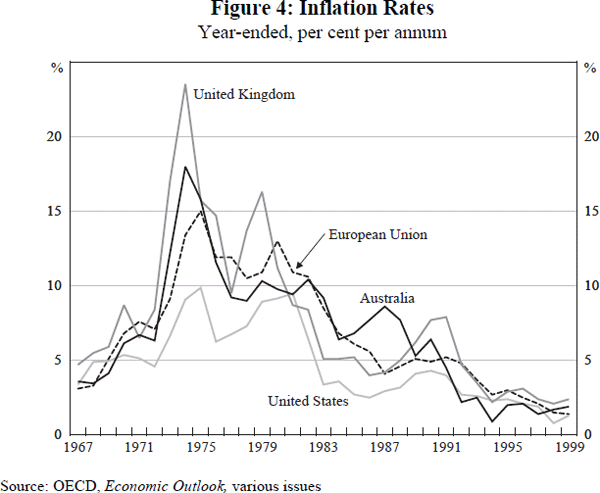
In all four regions the 1990s has also been a period not only of low, but also relatively stable, inflation. Moreover, as Table 1 shows, this low variability in inflation has not generally been bought at the expense of more variable growth rates. Of course, a major factor behind this has been the absence of major external shocks such as the oil price hikes. Nevertheless, macroeconomic policies in the OECD seem for the most part to have generally played a benign role, and have only rarely acted as a destabilising force. The main exception is obviously Japan. Here overly tight monetary policies, in conjunction with unwillingness to undertake necessary real and financial reform, have led to a decade of stagnation and the return of that Keynesian pathology, the liquidity trap (see Krugman (1998)). The other significant macroeconomic policy error was the handing by the Europeans of German re-unification. This would have been most comfortably handled by a revaluation of the Deutsche Mark, but a refusal by most (non-German) members of the Exchange Rate Mechanism to countenance this, coupled with an understandable reluctance on the part of the Bundesbank to lower German interest rates, led to a period of overly tight macroeconomic policies.
| Standard deviation | EU | US | UK | Australia |
|---|---|---|---|---|
| Inflation | ||||
| 1970s | 2.8 | 1.8 | 5.2 | 4.0 |
| 1980s | 3.1 | 2.6 | 2.3 | 1.6 |
| 1990s | 1.4 | 1.1 | 2.2 | 1.6 |
| Growth | ||||
| 1970s | 1.8 | 2.5 | 2.2 | 1.5 |
| 1980s | 1.2 | 2.5 | 2.3 | 2.2 |
| 1990s | 1.1 | 1.6 | 1.7 | 1.9 |
|
Source: Author's calculations from OECD data |
||||
Viewed in comparative perspective, Australia's success in keeping the variability of inflation and growth low is thus not especially remarkable. It should, however, be remembered that the Asian Crisis was of far greater significance for Australia than for Europe or the US. The cut in the cash rate of ½ a percentage point at the end of July 1997 soon after the Asian Crisis broke and the RBA's acceptance of the subsequent depreciation of the A$ by nearly a quarter, allowed Australian growth, sustained by strong domestic demand, to continue despite the downturn in key Australian export markets. The contrast with New Zealand is instructive. The RBNZ, with a Monetary Conditions Index (MCI) as its operational target, initially allowed short-term interest rates to rise to offset the depreciation of the NZ$, before subsequently cutting them in the second half of 1998. The consequence was a sharp reduction in growth in 1998. The RBA should therefore be allowed some credit for skillful navigation through this period. Simulations by the OECD (2000), using the OECD Interlink model, support this view. They suggest that compared to a counterfactual scenario of an unchanged real MCI, output (inflation) was 1 (¾) percentage point higher in 1998 and 1½ (2) percentage points higher in 1999 under the RBA's strategy.[2]
An interesting question is whether the generally low variability of output growth in the 1990s in most OECD countries is just a case of good luck, coupled with the absence of major policy errors (Japan excepted). Are there any reasons for expecting output growth to be less variable in the future than it was in the past? One possible reason might be the increasing share of services at the expense of manufacturing. Many of the goods produced by the latter are durable, and therefore consumption is decoupled from purchase. However, as noted by Gruen and Stevens (this volume) in their paper at this conference, this explanation is inconsistent with the fact that volatility has fallen in most industries during the last decade.
They note that deregulation and competition might have a role to play, without identifying a particular mechanism at work. I think it is, however, worth pointing to a particular consequence of the information and communications technology (ICT) revolution that may be important, namely the impact on business management and inventory control methods. Advances in computing power mean that producers and retailers can monitor their stock levels far more accurately than before and respond quickly when the need arises. On the face of it this might seem to imply a closer matching of production to movements in demand, and thus greater volatility if the primary source of disturbances to the economy is on the demand side. However, one thing we do know about inventories is that they are not anti-cyclical, as is predicted by the production-smoothing model in which inventories are held to smooth out production in the face of fluctuations in demand. Instead they are quite strongly pro-cyclical. Whilst a variety of explanations have been put forward for this apparently paradoxical behaviour, such as the presence of cost shocks, none has so far gained widespread acceptance. If the ICT revolution allows a closer matching of production to demand, it could reduce the importance of inventories as a business cycle magnification mechanism.
An alternative explanation is that the low volatility of both growth and inflation is in part a response to the generalised acceptance in most industrialised economies of the importance of stability-oriented monetary policies. Governments in all four of the regions under consideration now have monetary policy delegated to an independent central bank. Both the US and the EU (in the guise of the Bundesbank, the de facto hegemon of the European Monetary System) have, of course, had independent central banks for some while, whilst the RBA and the Bank of England have acquired responsibility for monetary policy only more recently. But in all four regions there is now a considerable degree of public confidence that inflation will be kept low and stable through appropriately pre-emptive monetary action. This, reinforced by formal inflation targets in the case of Australia and the UK, appears to have helped cement private sector inflationary expectations. Although it is difficult to test the hypothesis, this greater certainty about the inflationary outlook may quite plausibly have removed or attenuated one source of disturbances to the economy. It should also have helped to reduce the risk premia associated with nominally-denominated debt.
Are there good reasons for preferring an explicit inflation target along the Australian or British lines to what Mishkin (1997) calls the ‘just-do-it’ approach of the Americans? Or should one prefer some variant of the Bundesbank's reliance on an intermediate monetary indicator, an approach which survives today in one of the twin pillars of the European Central Bank's monetary strategy (the other being a ‘broad-based’ assessment of inflation prospects)? These are issues that have been discussed extensively at an earlier RBA conference (see Lowe (1997)) and I shall not dwell on them here. However, it does seem that an inflation target, provided it is specified and pursued sufficiently flexibly[3], does have considerable merit in terms of communicating the primary objective of the monetary authorities to the public. It also enhances democratic accountability by providing a clear mandate to the central bank. Both of these are particularly important to new central banks, or ones that have only recently acquired independent status.
So the conduct of Australian monetary policy has generally been good, although not notably superior to that of most other developed countries. In contrast the conduct of fiscal policy really does seem notable. Although budget deficits in the recession of the early 1990s approached 5 per cent of GDP, they pale into comparison against the burgeoning deficits in Europe (see Figure 5). Indeed budget deficits have generally been smaller than in our comparator countries for most of the last twenty years. Only very recently has the US bettered the Australian performance as a mix of high growth and determined efforts to halt the rising public debt ratio have held things in check. The good comparative fiscal position of Australia is even more pronounced if one looks at (net) public debt ratios (Figure 6). These are low in comparative terms and more importantly have not exhibited the same increasing trend observed in Europe and the US.
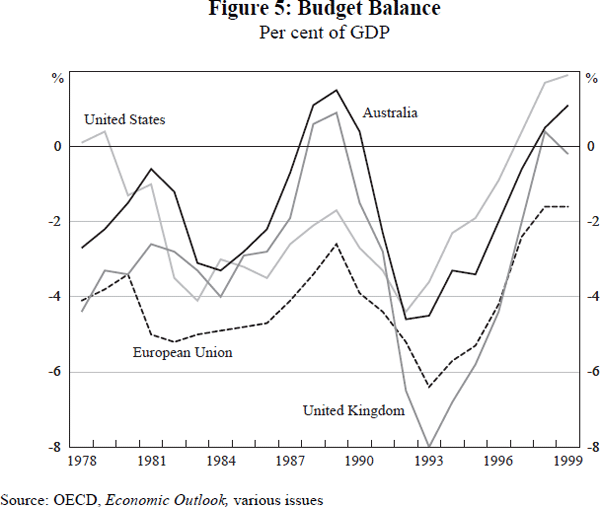
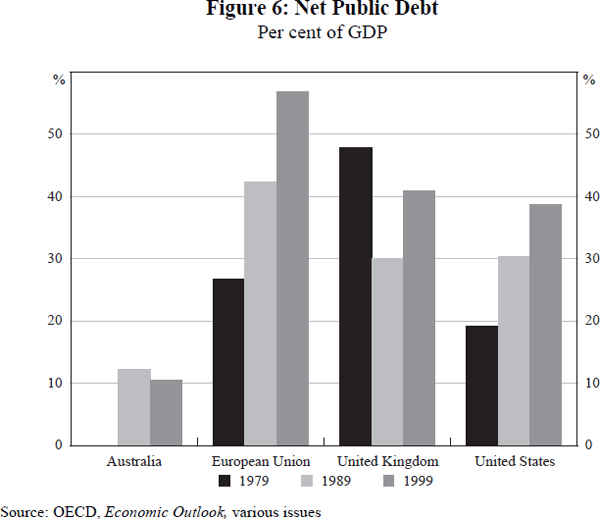
An interesting question is why successive Australian governments have managed to resist the temptation to borrow rather than tax to meet their spending commitments, when governments elsewhere, especially in Europe have so often failed. Certainly current fiscal innovations such as Charter for Budget Honesty (1998) and the adoption of accruals accounting are likely to help by increasing the transparency of fiscal policy and make it harder for profligate governments to conceal their behaviour. In fact openness in fiscal plans is a dimension along which antipodeans seem to be leading the way. For instance the New Labour government in the UK quite consciously models key aspects of its fiscal framework on the New Zealand and Australian examples. By contrast fiscal plans in some EU members are quite opaque, and accounting conventions allow governments to disguise the true budgetary position. This was most obviously the case in the run-up to the start of EMU when France, Germany and Italy all resorted to fiscal jiggery-pokery in order to satisfy the Maastricht entry criteria. However, the Charter for Budget Honesty and accruals accounting are only recent innovations, so they cannot be the main explanation for a responsible fiscal policy that dates back a couple of decades.
Rather the explanation probably lies in the belief, which survived until the late 1980s, that the current account deficit was a binding constraint on the country's ability to run an excess of national investment over national saving, and thus also on budget deficits. This view seems to have been held by many Australian policy-makers and economists until the late 1980s when it came under attack from John Pitchford (1989, 1990) and Max Corden (1991); see Gruen and Stevens (this volume) for a discussion of the evolution of thinking in Australia. In many other OECD countries, by contrast, this view had largely evaporated in the 1970s as obstacles to international capital mobility had progressively been removed. If this hypothesis is correct, then the realisation by Australian politicians that the current account is no longer a constraint raises the danger that less responsible fiscal policies might be adopted, particularly in the face of adverse shocks. In that case the recent innovations to increase openness and transparency in fiscal plans may well prove crucial.
Both a benign external environment and judicious macroeconomic policies thus seem to have played a role in sustaining robust, but non-inflationary, growth. Given this lack of inflationary pressure supply-side developments must also have been beneficial. The rest of this paper will therefore concentrate on this side of the story. I start by looking at developments in labour markets in Australia and elsewhere. Then I will look at the behaviour of productivity, and in particular at the roles played by information technology and deregulation. Finally I will return to the question of the current account and the savings/investment balance.
3. Labour Markets
Figure 3 showed that Australia suffered the same trend increase in unemployment during the 1970s and 1980s as much of the rest of the OECD and especially Europe. Since early in the 1990s, however, unemployment has been falling, matching the falls seen in the UK although falling short of the extraordinary performance of the US; it is in stark contrast to the experience of much of the EU where unemployment rates have only recently begun to fall much. As noted in Section 2, this was in spite of the stabilisation of inflation, so cannot represent a purely cyclical phenomenon.[4] In this section I shall look more closely at the comparative labour market performance of Australia, noting which labour market institutions seem to be desirable on the basis of the international evidence and which might be improved.
3.1 Existing literature
There is now a large literature on the great rise in unemployment experienced by so many developed countries during the 1970s and 1980s; surveys include Bean (1994a), Nickell (1998) and Layard and Nickell (1998). Much of the initial debate revolved around the question of the relative importance of supply and demand factors, with some authors stressing the importance of generous unemployment benefit provisions, high levels of employment protection, and strong unions in generating excessive real wages, whilst others stressed the role of contractionary macroeconomic policies. This simple ‘Supply versus Demand’ dichotomy still survives in much media and political discussion of the unemployment problem, particularly in Europe. However research in academia and the OECD has pointed to a rather more complex picture in which a series of adverse shocks have interacted with institutions which, whilst of themselves not necessarily generating high unemployment, do mean that the economy is less efficient at dealing with the shocks. Perhaps the most eloquent statement of this view is contained in Blanchard and Wolfers (2000), but the idea underlies much of the earlier work in this field.
That an explanation in terms of deficient demand cannot fit the facts is fairly obvious just from Figures 3 and 4. The standard undergraduate text book model has a natural rate of unemployment determined by structural factors such as the generosity of unemployment benefits, coupled with demand-driven fluctuations around that natural rate; there is a short-run trade-off between unemployment and inflation, but no long-run one. Only the US experience even approximates this model (and then not in the most recent past). In most of the other OECD countries unemployment stayed high long after inflation had stabilised. That invites the alternative hypothesis that perhaps the natural rate itself has risen. Implicitly such an outcome was always a possibility even in Milton Friedman's (1968) original formulation of the natural rate hypothesis, but it was not a possibility that economists focussed on until recently. Researchers then began to develop empirical models of the natural, or equilibrium, rate of unemployment with progressively richer structures. The original Layard-Nickell (1986) model and the work of Phelps (1994) are examples of this ‘structuralist’ approach to understanding high unemployment.
The difficulty with the story is that in most countries there were no obvious major changes in labour market institutions that could plausibly generate such a large increase in the equilibrium rate of unemployment. Admittedly in some European countries unemployment benefit regimes became more generous and employee protection legislation somewhat stronger, but the changes were small relative to the pre-existing differences between countries. Europe also had more generous unemployment benefit provisions, more employment protection, higher unionisation, etc, in the 1950s and 1960s too, yet unemployment rates then were low relative to the US.
The other striking thing about Figure 3 is that the main increases in unemployment are coincidental across countries (this is also true if the EU is broken down into its constituent countries, and other countries such as Canada and New Zealand are included in the analysis). This suggests that the prime drivers behind the movements in unemployment are likely to be common across the OECD countries, with the heterogeneous country experience explicable in terms of different reactions to those shocks. The list of potential common shocks includes:
- The slowdown in total factor productivity (TFP) growth at the beginning of the 1970s. Whilst a very long-run historical perspective suggests that the level of productivity must be neutral in terms of its effect on equilibrium unemployment [5] because the former is trended whilst the latter is not, the same argument does not apply to productivity growth. In the early unemployment literature the argument was simply that workers were slow to adjust their wage aspirations downwards, leading to excessive real wages relative to the economy's ability to pay. This should clearly be just a transitory effect that will disappear once expectations have adjusted. However, there are two possible effects from productivity growth that might be more permanent. On the one hand higher productivity growth raises the expected future profitability from opening up a new job slot and increases the rate of job creation (this is referred to as the ‘capitalisation effect’; see Pissarides (1990)). On the other hand if productivity growth occurs through ‘creative destruction’, with old jobs being replaced by new ones, it will also lead to a higher rate of job destruction (Aghion and Howitt 1994). In principle either effect could dominate, although there is some mild evidence that the former dominates empirically (see Alogoskoufis et al (1995)). This may be relevant in considering the likely impact on Australian unemployment of the pick-up in productivity growth that is discussed in the next section.
- Movements in the price of oil and other raw materials, especially in 1974 and 1979. This lowers the consumption wage for any product wage and raises equilibrium unemployment if workers try to maintain their purchasing power.
- The contractionary macroeconomic policies that squeezed inflation down in the early 1980s and again in the early 1990s. Although the extent of the squeeze may have varied from country to country, the timing was largely coincidental across countries, giving it the appearance of a common shock.
- The increase in world real interest rates that occurred around the middle of the 1980s. This reduces the present value of the profits associated with a job, reducing investment in all forms of capital. The result is a decline in the rate of job creation and an increase in the rate of job destruction unless wages fall sufficiently. The mechanism figures prominently in Phelps' (1994) explanation of the rise in unemployment.
- A fall in the demand for unskilled workers due to increased competition from low-cost producers in the Far East. The result follows directly from the Stolper-Samuelson theorem that international trade benefits the relatively abundant factor(s) (skilled labour and capital in the OECD). If unskilled workers resist the required decline in wages, as Krugman (1994) suggested happened in Europe, then the result is rising unemployment.[6] This line of argument has been pushed most strongly by Wood (1994), but subsequent research has tended to suggest it is likely to explain just a small fraction of the increase in wage inequality in the US/unemployment in Europe.
- A fall in the demand for unskilled workers stemming from skill-biased technical change. This has similar effects to the global competition story, but as Krugman (1994) points out helps to explain the fact that the widening in the US earnings distribution has occurred within occupations as well as between them. It also explains the apparent fall in the demand for unskilled labour in the non-tradeable sector of the economy, even though wages of unskilled workers were stagnant or falling.
There are, of course, also country-specific shocks that may have been important. One factor that has achieved quite a lot of attention in continental Europe is increases in labour taxes, particularly on employers, to pay for the high level of social security spending (see Daveri and Tabellini (2000)). In addition, demand movements have not always been synchronised, the most obvious idiosyncratic demand shock being associated with German re-unification. However, the big picture seems clearly to be one of heterogenous responses to largely common shocks.
The main factors that the literature has identified as determining the response to such shocks are:
- The generosity of unemployment benefit regimes, encompassing not just replacement ratios, but also the duration for which unemployment benefits (or some equivalent state support) are payable, the coverage of the benefit system and the vigour with which any work test is applied. Generally speaking, generous benefit regimes are expected to raise the equilibrium rate of unemployment, magnify the response to shocks and increase unemployment persistence. With regards to the last of these, authors such as Layard, Nickell and Jackman (1991) have pointed particularly to benefits that are payable indefinitely as a key ingredient in helping generate long-term unemployment. In turn they argue that the long-term unemployed are less effective job seekers than the newly unemployed because they become disconnected from the labour market and so are less effective at constraining wage pressure.
- The structure of wage bargaining, including the level of unionisation and the extent of co-ordination between unions and employers and the government in the setting of wages. High levels of union power are usually thought to be bad for unemployment, but a high level of co-ordination between unions and employees can ameliorate the response to adverse shocks by helping to internalise externalities from bargaining and the problems posed by the staggering of wage settlements. A notable contribution by Calmfors and Driffill (1988) argues that the relationship between the number of unions and unemployment should be non-monotonic with the intermediate position of a number of large unions being the worst of all worlds.
- Employment protection legislation. The effect of this on equilibrium unemployment is not immediately clear in that it reduces both the flows in and out of the unemployment pool, and indeed in the simplest models, such as that of Bentolila and Bertola (1990) it has a negligible effect on the average level of unemployment. It does, however, have an effect on the dynamics of unemployment by reducing the speed of adjustment and can generate hysteresis in (un)employment. In addition high levels of employment protection are a potent source of insider power and can help to generate the effects seen in insider-outsider models of the kind advanced by Lindbeck and Snower (1989). The interaction of high levels of employment protection for those on permanent contracts coupled with sectoral bargaining appears to be an important ingredient in explaining why unemployment in Spain was so high until the recent reforms.
- Spending on active labour market programmes (ALMPs) that help the unemployed, particularly the long-term unemployed, find work or retrain. They can be thought of as representing the ‘carrot’ that goes with the ‘stick’ of a tight unemployment benefit regime. The most important effect of these programmes is likely to be increasing the speed of recovery after a shock. However, Calmfors (1994) notes that badly designed active labour market programmes can also raise equilibrium unemployment, for by reducing the unpleasantness of a spell of unemployment and thus raising the outside option of workers they can also raise the equilibrium wage.
- The flexibility of nominal wages, for if nominal wage contracts are relatively long-lived the effect of shocks, both nominal and real, is likely to be greater and longer lasting.
3.2 A simple cross-country model
In order to see where Australia lies in the scheme of things, I shall utilise some simple empirical estimates that employ and extend a methodology applied in Bean (1994b). This relies on first using a non-linear generalised fixed effects model for the unemployment rate in a panel of 18 OECD countries, during 1956–99, to estimate the common shocks and country-specific responses to those shocks. The model takes the following form:

where: uit is the logarithm[7] of the unemployment rate in country i in year t; αi is a country-specific fixed effect corresponding to the average value of the (logarithm of) the natural rate of unemployment in country i over the sample; γt is a time-specific fixed effect representing the common shocks, whose impact on country i is allowed to vary via the country-specific coefficients βi; λi are country-specific speeds of adjustment; εit is an idiosyncratic disturbance; and Δ denotes a first difference. The γt are specified so that they sum to zero over the sample period. Finally to be able to identify the βi and γt separately we also need to make one normalising assumption, namely that βAustralia is set to unity. This sort of model can be thought as representing the reduced form of a standard dynamic ‘battle-of-the-mark-ups’ model of the equilibrium rate of unemployment.
One would only expect this to provide a good model of unemployment movements if: (i) shocks are predominantly common rather than idiosyncratic; and (ii) changes in labour market institutions are small compared to the pre-existing differences between national institutions. Both of these seem to be reasonable assumptions over this particular sample period. The presence of serially uncorrelated idiosyncratic disturbances causes no difficulty. Thus if one were to assume a ‘price surprise’ supply function of the standard New Classical variety one could accommodate purely national business cycle effects. Serially correlated idiosyncratic shocks will, however, generate downward bias in the adjustment coefficient λi, although if the serial correlation process in the εit is similar across countries the ranking of the λi should be unaffected. Any changes in labour market institutions that affect unemployment will obviously show up as movements in this idiosyncratic component.
Equation (1) is estimated by non-linear least squares. The estimated country-specific
coefficients  are plotted in Figure
7.[8]
Australia is pretty much in the middle of the pack as regards
are plotted in Figure
7.[8]
Australia is pretty much in the middle of the pack as regards  and
and  (mean natural rate
and responsiveness to shocks), but has the highest
(mean natural rate
and responsiveness to shocks), but has the highest  of any country, suggesting
relatively rapid adjustment and therefore comparatively low unemployment persistence.
of any country, suggesting
relatively rapid adjustment and therefore comparatively low unemployment persistence.
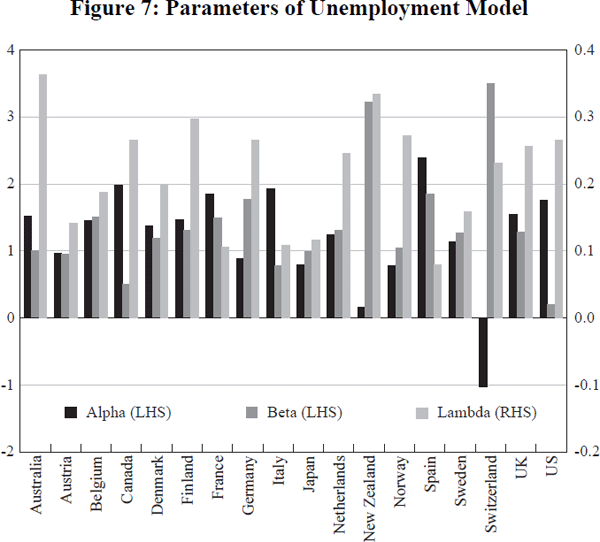
In order to shed further light on the causes of the inter-country differences in the estimated parameters and the nature of the driving shocks, we next relate them to variables reflecting institutional differences between countries and to observable measures of the shocks. Such a two-stage process is more robust than simply including the observable shock and institutional variables in the first-stage regression instead of the time and country-fixed effects.
Following the discussion above, the institutional variables we include in the models
for  are: the unemployment benefit replacement
ratio; the duration for which such benefits are payable; the share of output/head
spent on ALMPs; for
are: the unemployment benefit replacement
ratio; the duration for which such benefits are payable; the share of output/head
spent on ALMPs; for  a measure of union
power, expected to raise average unemployment; for
a measure of union
power, expected to raise average unemployment; for  and
and  a measure of union-employer
co-ordination on the grounds that corporatist economies should exhibit more
muted response to shocks and more rapid adjustment; for
a measure of union-employer
co-ordination on the grounds that corporatist economies should exhibit more
muted response to shocks and more rapid adjustment; for  and
and  a measure of the flexibility
of nominal wage contracts based on the length of contracts, the extent of indexation
and the degree of synchronisation of settlements; and finally for
a measure of the flexibility
of nominal wage contracts based on the length of contracts, the extent of indexation
and the degree of synchronisation of settlements; and finally for  a measure of the extent
of employee protection. All of these variables are taken from Layard et al
(1991) with the exception of the employment protection measure which is drawn
from the recent OECD (1999) study.
Appendix A provides fuller detail on the data used.
a measure of the extent
of employee protection. All of these variables are taken from Layard et al
(1991) with the exception of the employment protection measure which is drawn
from the recent OECD (1999) study.
Appendix A provides fuller detail on the data used.
The results for the national coefficients  are provided in Table 2. This table also
gives the value of each of the explanatory variables for Australia, together
with the average value for the other 17 countries so that the reader can see
whether Australia rates high or low on each characteristic. Given both the
small sample and the broad-brush nature of the analysis, the results are surprisingly
sensible. Generous unemployment benefits raise average unemployment, increase
the sensitivity of unemployment to shocks and raise unemployment persistence.
The same is generally true if benefits are payable for a long period, although
the effect on persistence is perverse; this runs counter to a number of other
results in the literature suggesting that high benefit duration significantly
raises persistence. Spending on ALMPs tends to lower average unemployment and
reduce persistence. It apparently raises the response of unemployment to shocks,
but the effect is statistically weak. Union power raises unemployment, whilst
a high degree of union-employer co-ordination reduces both the responsiveness
to shocks and speeds adjustment. A low degree of nominal rigidity reduces both
average unemployment and the response to shocks. Finally, high levels of employment
protection have a very strong statistical effect in reducing the speed of adjustment
and thus in raising unemployment persistence.
are provided in Table 2. This table also
gives the value of each of the explanatory variables for Australia, together
with the average value for the other 17 countries so that the reader can see
whether Australia rates high or low on each characteristic. Given both the
small sample and the broad-brush nature of the analysis, the results are surprisingly
sensible. Generous unemployment benefits raise average unemployment, increase
the sensitivity of unemployment to shocks and raise unemployment persistence.
The same is generally true if benefits are payable for a long period, although
the effect on persistence is perverse; this runs counter to a number of other
results in the literature suggesting that high benefit duration significantly
raises persistence. Spending on ALMPs tends to lower average unemployment and
reduce persistence. It apparently raises the response of unemployment to shocks,
but the effect is statistically weak. Union power raises unemployment, whilst
a high degree of union-employer co-ordination reduces both the responsiveness
to shocks and speeds adjustment. A low degree of nominal rigidity reduces both
average unemployment and the response to shocks. Finally, high levels of employment
protection have a very strong statistical effect in reducing the speed of adjustment
and thus in raising unemployment persistence.
| Dependent variable | |||
|---|---|---|---|
 |
 |
 |
|
| Constant | 0.748 (1.82) |
0.953 (1.31) |
0.357 (8.99) |
| Replacement ratio – % (Australia: 39; average: 61.7) |
0.023 (2.34) |
0.006 (0.59) |
−0.001 (1.68) |
| Benefit duration – months (Australia: 48; average: 30.7) |
0.007 (1.63) |
0.017 (3.03) |
0.001 (1.37) |
| Labour market programmes (Australia: 2.8; average: 7.8) |
−0.018 (1.36) |
0.021 (0.79) |
0.001 (0.55) |
| Union power (Australia: 1; average: 0) |
1.236 (3.55) |
||
| Union-employer coordination (Australia: 3; average: 4.1) |
−0.081 (0.42) |
0.017 (1.04) |
|
| Wage flexibility (Australia: 6; average: 3.6) |
−0.292 (2.89) |
−0.082 (0.42) |
|
| Employee protection (Australia: 1.2; average: 2.1) |
−0.077 (7.06) |
||
| R2 | 0.462 | 0.232 | 0.454 |
| Note: Heteroscedasticity-consistent (White) t-statistics in parentheses | |||
As noted, Australia seems to have pretty average values of α and β, but a high value of λ. In terms of lowering α and β Australia scores well[9] in terms of having a low replacement ratio, but badly on the duration for which benefits are payable. It also does badly on account of relatively high union power and low spending on active labour market programmes. On the other hand it does well in terms of a high degree of nominal wage flexibility which tends to lower unemployment. So it is a bit of a mixed bag. As far as the relatively rapid speed of adjustment, λ, goes, Australia again scores well because of low replacement ratios, and does especially well in terms of a low level of employment protection.
However, it should be noted that most of these institutional indicators are based on pre-1990 data (the main exception being the employment protection series). The 1990s have seen a number of important labour market reforms that on the basis of these results might have been expected to improve the functioning of the labour market. The most important of these are:
- Limitations on union power through the Workplace Relations Act 1996.
- An extension of ALMPs through the Working Nation programme (1994) focussed especially on re-integrating the long-term unemployed back into the labour market.
- The re-organisation of, and introduction of competition into, the employment services market (1997).
- A workfare scheme for the young unemployed (Work for the Dole, 1997) that emphasises the obligation to work or train in return for state support. This is very similar in both concept and design to the UK government's New Deal program.
Because of these reforms one might expect unemployment to have been lower than would have been predicted from an equation estimated on a sample including earlier data. To investigate this we can examine the residuals from the model for Australian unemployment over the 1990s. The implied actual and (one-step ahead) predicted levels of the unemployment rate are plotted in Figure 8. There is a tendency to overpredict unemployment in 1990–92, but the equation tracks quite well in the latter part of the decade. Remembering that inflation has been relatively stable in most OECD countries, including Australia, during the latter part of the 1990s, it does suggest that, to date at least, the labour market reforms of the last decade may not yet have borne significant fruit.
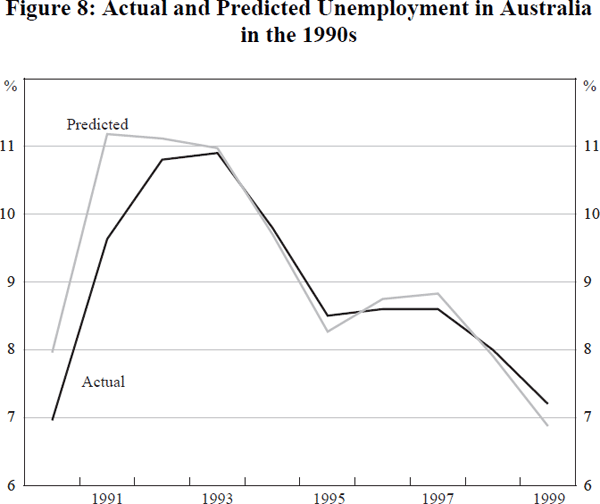
To complete the picture we briefly report estimates of a model for the sequence of
time dummies  describing the common shocks. As explanatory
variables we include: the current and lagged change in the rate of growth of
nominal GDP in the OECD (Δx) to pick up world business cycle
effects; the (lagged logarithm of the) relative price of raw material and fuel
to the price of OECD exports
describing the common shocks. As explanatory
variables we include: the current and lagged change in the rate of growth of
nominal GDP in the OECD (Δx) to pick up world business cycle
effects; the (lagged logarithm of the) relative price of raw material and fuel
to the price of OECD exports  as a measure of the
OECD terms of trade; the
growth-corrected real short interest rate, that is the nominal short
interest rate minus the rate of growth of nominal GDP (RS–Δx),
since it is this variable that models of the natural rate such as those of
Pissarides (1990) and Phelps (1994) suggest are relevant rather than the conventional
real interest rate; and the term structure of nominal interest rates (RL–RS).
We also include a time trend to control for the effects of globalisation and
skill-biased technical change. The results are (White t-statistics
in parentheses):
as a measure of the
OECD terms of trade; the
growth-corrected real short interest rate, that is the nominal short
interest rate minus the rate of growth of nominal GDP (RS–Δx),
since it is this variable that models of the natural rate such as those of
Pissarides (1990) and Phelps (1994) suggest are relevant rather than the conventional
real interest rate; and the term structure of nominal interest rates (RL–RS).
We also include a time trend to control for the effects of globalisation and
skill-biased technical change. The results are (White t-statistics
in parentheses):

Again the results are fairly sensible, although the importance of the trend represents a measure of the incompleteness of the explanation.
4. Productivity
We now turn to the behaviour of productivity. Underpinning Australia's good economic performance over the last decade has been a high rate of productivity growth, both in historical terms and relative to other countries. This is documented in Figure 9, which gives the average annual rate of growth of total factor productivity (TFP) in the business sector of the economy for Australia, the EU, the UK and the US for the four sub-periods: 1960–73; 1974–79; 1980–1991; and 1992–97.
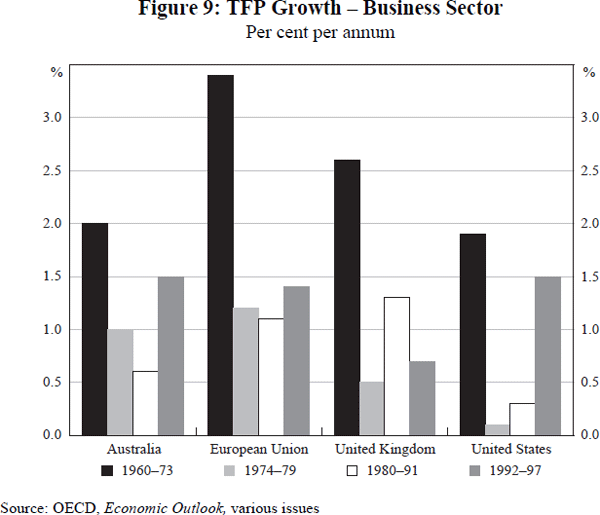
Whilst hardly disastrous, the Australian economy's performance during the first three periods was generally below par compared to that of other members of the OECD with similar per capita GDP; the apparently weak performance of the US – the technological leader – merely indicates the limited catch-up possibilities there, of course. The most recent period, however, shows Australia rivalling even the resurgent US economy[10] which many believe is experiencing a sustained increase in TFP growth caused by the burgeoning information and communications technology (ICT) revolution. An obvious question is whether the Australian experience reflects the operation of similar forces, or whether something else is at work.
4.1 A technological miracle?
As Figure 9 makes clear, the acceleration in US TFP growth is a relatively recent phenomenon, dating from the second half of the 1990s. Despite rapid advances in computing power, the advent of the personal computer, networking, etc, the ICT revolution for a long time seemed to have had a negligible effect on productivity in the US and elsewhere, leading Solow (1987) famously to quip that ‘the computer age is everywhere but in the productivity statistics’. This so-called ‘productivity paradox’ has been the subject of a now rather extensive literature; key empirical studies establishing the apparently negligible impact of ICT investment on (US) productivity include Oliner and Sichel (1994), Jorgenson and Stiroh (1995), and Sichel (1997).
There are basically five extant explanations for this productivity paradox (see Pohjola (1998)).
- That there is in fact no paradox at all. Much of the ‘new’ growth literature, particularly in respect of the ‘weightless’ economy, draws attention to the non-rivalness of ideas and blueprints, and to the associated increasing returns and externalities. In that case conventional growth accounting techniques will understate the contribution of ICT investment to TFP growth because they ignore such externalities. Jorgenson and Stiroh question whether there are indeed such non-pecuniary externalities from ICT investment, arguing instead that any externalities are pecuniary in nature and therefore fully taken account of in growth accounting calculations. Hence there is no paradox.
- That output and productivity are mismeasured because much of the gains from the ICT revolution are in the form of quality improvement and do not figure in the official measures of output and productivity, although they nevertheless may result in an improvement in the standard of living. Now it is true that allowing for quality improvements is difficult, but statisticians have been dealing with this sort of problem for years and have devised all sorts of ingenious ways to try to handle it. It is not clear that the ICT revolution has made things any worse than they were before. Ultimately this explanation does not seem very satisfying.
- That the new technology needs to be matched to an appropriate organisational structure within the firm. Brynjolfsson and Hitt (1997) note that successful exploiters of ICT investment are typically decentralised in structure with a high premium on knowledge. ICT investment in the wrong sort of firm may lead nowhere. However, whilst this may explain why some investing firms do better than others, it does not seem to be a very convincing explanation of the absence of any noticeable aggregate effects.
- Greenwood (1997) argues that there is a complementarity between new technologies and appropriate worker skills. With most new technologies there is usually a diffusion lag as workers have to come to grips with the new technology before they can exploit it. Indeed during the learning phase productivity growth is likely to decline. He provides a number of examples from history of this phenomenon. Modest US TFP growth in the 1980s and early 1990s, together with a take-off in recent years can then be explained as being simply a consequence of this diffusion lag.
- Finally, even though the marginal returns from ICT investment may be high, the current stock of ICT capital is still small; for instance computers comprise only about 3–4 per cent of the US net capital stock. This means that, whilst very visible, they are nevertheless still relatively unimportant as a factor of production and will contribute relatively little to growth accounting exercises.
Whilst there was little evidence of a noticeable ICT effect on US TFP in the first half of the decade, this is no longer true when the latter half of the 1990s are taken into account. Alan Greenspan's (1996) – at the time derided – remark that ‘the rapid acceleration of computer and telecommunication technologies can reasonably be expected to appreciably raise our productivity and standards of living in the 21st century, and quite possibly in some of the remaining years of this’ looks remarkably prescient. Even long-time sceptics such as Robert Gordon recognise that something real has happened to raise the growth rate of potential output in the US, although he notes that there is little evidence of any structural change outside the IT production sector itself (Gordon 1999). Specifically he calculates that a little over half of the 1.1 percentage point acceleration in labour productivity growth since the end of 1995 is attributable to cyclical factors and improvements in price/quality measurement, with the remainder attributable to structural effects, but that the latter disappear if the IT production sector is excluded. The fact that the gains are confined to the IT sector accords with the Jorgenson-Stiroh (1995) view that beneficial spillovers and externalities from IT are (presently, at least) rather limited.
So where does this leave the Australian productivity miracle? A number of commentators have noted that Australia is relatively advanced amongst the industrialised countries in terms of the speed of adoption of the new information technologies (see e.g. The Economist (2000)). However, whilst it may be advanced, it does not appear to be that advanced. This can be seen from Figure 10, which shows a cross-country comparison of internet penetration as of 1998/99. While Australia shows higher levels of internet usage than the UK, and much higher usage than Japan, France or Germany, it is still quite some way behind the US and the Nordic countries. Given that Australia appears to lag somewhat behind the US and the Nordic countries in ICT adoption, it is highly unlikely to have led the way as an exploiter of ICT. The fact that the Australian TFP take-off is coincident or even precedes that of the US suggests the cause is therefore unlikely to be ICT. Moreover, Australia is not an IT producer, but rather an IT importer, so if one believes Gordon's finding that ICT has mainly benefited the IT production sector, one should not expect it to have had much effect on Australian productivity.
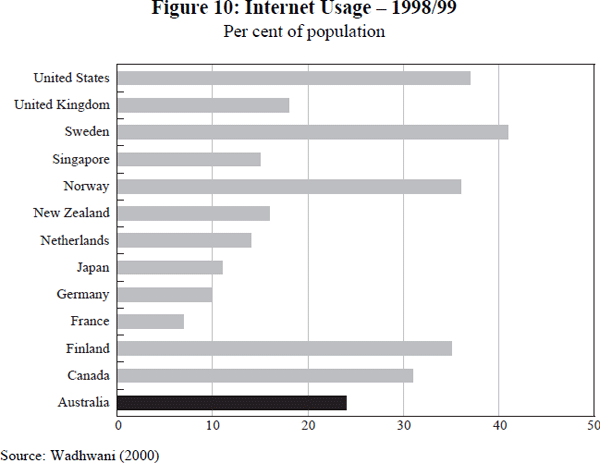
To put a little more flesh on this hypothesising I have run a simple cross-country regression for the OECD countries of average TFP growth in the business sector over 1992–97, (a), on: the share of ICT investment in GDP in 1996 (ict) taken from Pohjola (1998); a measure of product market regulation (pmr) due to Nicoletti, Scarpetta and Boylaud (1999) whose role is discussed later; and the logarithm of per capita GDP relative to that of the US (y−yus) to capture catch-up effects. I also include a zero-one dummy to control for Switzerland which is a rather large outlier over this period. I have tried adding TFP growth over 1980–91 (to capture any serial dependence) and the change in unemployment between 1991 and 1997 (to control for cyclical effects); neither are significant or have any major impact on the estimated coefficients. The results are (White t-statistics in parentheses):

Both the ICT investment and catch-up terms thus have a statistically significant impact on TFP growth. Since the ‘direct’ effect of ICT investment is already taken account of in the construction of TFP growth, the ICT term here captures any beneficial spillover effects of ICT due to the presence of positive externalities. In respect of the catch-up term it is worth noting in passing that the estimated coefficient suggests that 3 per cent of any productivity gap is eliminated per year. This is close to the rate usually found in cross-country convergence regressions.
Investment in ICT is not only statistically significant, but its economic impact is also quite large, implying roughly a point-for-point response of TFP growth to an increase in the share of GDP spent on ICT investment. However, it does little to explain the Australian productivity miracle since the Australian ICT investment share is only 2.6 per cent compared with an average for the rest of the countries in the sample of 2.5 per cent (the US has the highest share at 3.9 per cent). Thus the regression attributes only about 0.12 percentage points of the excess Australian TFP growth to unusually high spending on ICT investment. By contrast a little over half a percentage point of Australian TFP growth is left unexplained altogether.
Of course, this regression model is pretty simple and one would not want to read too much into it. Nevertheless, taken together with the observation that Australia does not have especially high levels of computer usage penetration, and that the TFP acceleration in the acknowledged leader, the US, is itself only recent, it does suggest that the explanation for Australia's good comparative productivity performance is not to be found in ‘new economy’ explanations.
4.2 The role of structural reform
A more plausible explanation for the good productivity performance of recent years would seem to be the complementary reforms that have steadily taken place in both labour and goods markets. For the first half of the post-war period economic institutions in Australia seem to have been built around the objective of redistributing rents, particularly from the rich primary commodity sectors. Key ingredients in this policy were high and complex levels of import protection, especially for manufacturing, and a centralised wage bargaining system that fixed a multitude of minimum terms and conditions for employment relationships. Scepticism about the wisdom of these policies began to emerge during the 1970s in a variety of reports and enquiries, e.g. the Jackson Committee (1975), leading to a steady, if sometimes erratic, reversal of these policies that continued into the 1980s and beyond.
Key reforms have been:
- A reduction in tariff barriers. Even in the late 1980s these were still high
by international standards; by 1996 they were lower than in both the US and
the EU (see Figure 11). First, trade barriers prevent the full exploitation
of comparative advantage and imply, absent other distortions, that a country
is not operating at the optimal point on its production possibility frontier,
leading to lower real national income. Second, openness increases competitive
pressure on domestic producers and, as noted below, the econometric evidence
suggests this is good for growth. Third, openness to trade facilitates the
international transmission of knowledge (see Coe and Helpman (1995)). A measure
of openness is a significant explanatory variable in many cross-country growth
regressions.
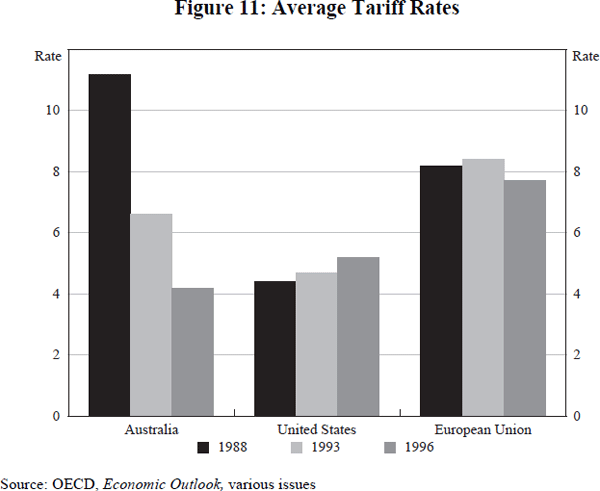
- Greater decentralisation in wage setting and industrial relations. Key recent moves include the Workplace Relations Act 1996 which shifted the focus of workplace relations away from centrally determined awards towards bargaining at the enterprise level, with awards restricted to 20 ‘allowable’ matters. It was also designed to facilitate enterprise bargaining by making individual and non-union agreements easier to implement. Finally it restricted the right to take industrial action with the result that strike activity is about one-sixth the level of 20 years ago. To the extent that these reforms have helped restore the ‘right-to-manage’ to employers they should facilitate a more efficient organisation of production. This will show up as an enhanced level of TFP.
- Increased product market competition through the ending of anti-competitive legislation and practices in some industries, and through a more vigorous application of competition policy. The impact of competitive pressure on productivity, and more particularly productivity growth, is in principle ambiguous. On the one hand competitive pressure ensures that the most efficient producers should survive and prosper. On the other, competition erodes the quasi-rents associated with successful innovation, thus reducing the incentive to innovate in the first place. The empirical results of Nickell (1996) suggest that the net effect of these two opposing forces is positive.
- Greater commercial pressures on government business enterprises through more explicit commercial objectives and the use of appropriate performance indicators, exposure to normal competitive pressures and in some cases outright privatisation. However, with the exception of one or two states such as Victoria, privatisation has not been as extensive as in the UK.
Whilst it is possible to calculate measures of effective levels of tariff protection, it is harder to construct measures that encompass the multi-dimensional nature of regulation, broadly considered, for Australia and the other OECD countries whose performance provides the benchmark. However, a heroic effort has recently been made to do exactly this by Nicoletti et al (1999). Their research uses factor analysis to distill information from a 1998 OECD questionnaire concerning economy-wide and sector-specific laws, regulations and administrative procedures into a variety of summary measures of the extent of product market regulation. These are distinguished under two broad headings – inward-oriented policies and outward-oriented policies – depending on whether the regulations are directed at domestic or foreign firms. Facets incorporated into the measure of inward-oriented regulations include: the extent of public ownership; the extent of involvement of the state in private business, e.g. through price controls; administrative burdens and opacities on business; and legal obstacles to competition, such as barriers to entry. Facets incorporated into the measure of outward-oriented regulations include: tariffs; restrictions on foreign ownership of firms; and regulatory barriers to international exchanges.
The measures for each country according to each of the two classes of regulations appear in Figure 12. As far as inward-oriented regulations go, the least regulated is the UK, with the US third and Australia fifth. The southern European countries do particularly badly. Australia comes joint second (with Ireland) on the measure of outward-oriented regulations, with the UK again first, whilst the US is joint ninth. There are less marked differences between countries in respect of this second set of characteristics because outward-oriented policies are increasingly governed by multilateral agreements and supranational institutions such as the World Trade Organisation. The authors also combine the two measures into a single overall measure of the extent of product market regulation, in which the UK comes top, followed by Ireland, Australia and the US, with the Mediterranean countries again bringing up the rear.
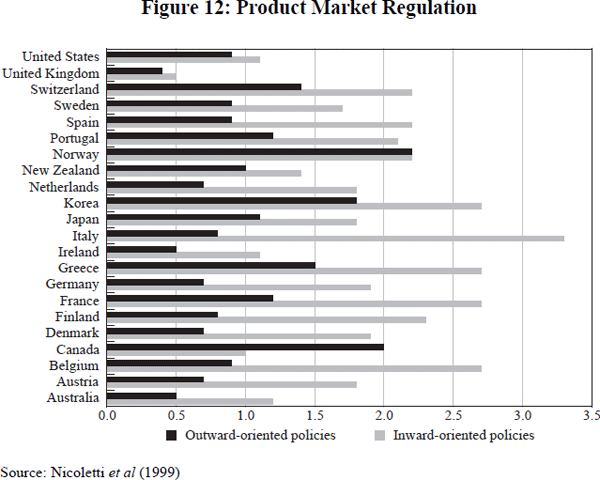
It is this composite indicator of the extent of product market regulation (pmr) that appears in the cross-country regression for TFP growth above (Equation (3)).[11] Since a low value of the indicator indicates a competitive product market environment we would expect it to have a negative sign. Instead the coefficient is positive, but insignificantly so. This is less worrying than it might seem for the hypothesis that the productivity resurgence has its roots in past structural reform. The primary effect of regulation is to ensure that a country is operating inefficiently, i.e. it lowers the level of TFP. The removal of regulations and barriers to competition should thus show up as a temporary spurt in TFP growth as a country gets closer to its production possibility frontier. So the explanatory variable one really wants is the change in product market regulation. Unfortunately the Nicoletti et al (1999) study only really provides a snapshot of the state of play in 1998, not how far the countries have progressed over the preceding period, and there is no earlier comparable study available to use to construct a measure of the change in regulations. Moreover, there is no particular reason to think the current level of regulation is necessarily strongly correlated with its past change: Australia and the UK have travelled a long way in recent years, but US product markets have always been fairly deregulated and competitive.[12]
The importance of structural reform is also highlighted in the recent report by the Productivity Commission (1999), which draws on a number of case studies as well as marshalling the macroeconomic evidence. It would, of course, be instructive to try to identify exactly which aspects of the reform process have been most significant. This is not an easy task, but a little evidence is provided by Figure 13 which gives a sectoral breakdown of TFP growth in the 1990s. To control for different cyclical behaviour across industries, the data refer to the growth of trend TFP (measured using a Hodrick-Prescott filter) rather than raw TFP growth. The data suggest that the level of trend TFP growth over the whole 1988–98 period has been highest in the utilities, communications and finance sectors. Utilities will have benefited particularly from increased commercialisation in the government enterprise sector, whilst communications and finance will have particularly benefited from the ICT revolution. If, however, we look at the change in TFP growth between the first and second quinquennia we see that it is construction and the wholesale trade that have experienced the largest acceleration, followed by agriculture, retail and transport. These are relatively labour-intensive sectors and which are therefore likely to have benefited particularly from the extension of management control associated with reforms to the industrial relations scene.
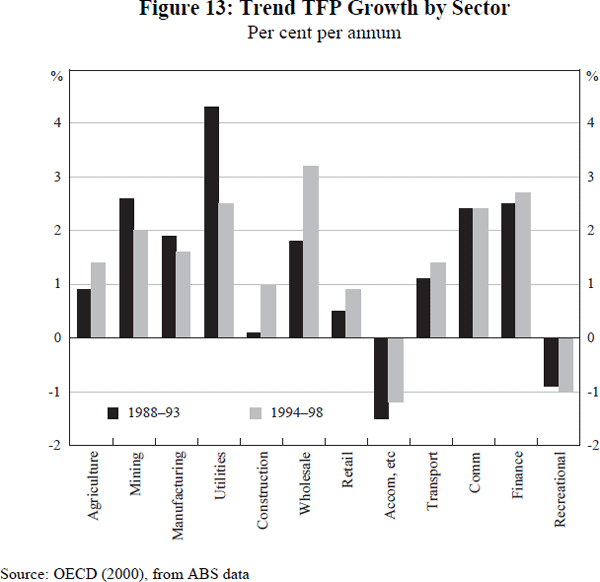
4.3 A cautionary tale
An important question is whether this good relative productivity performance can be expected to continue. To what extent is this the working out of a once-off level effect as Australia closes some of the gap with the US, and to what extent does it presage a higher rate of trend productivity growth for some years to come? To the extent that high recent productivity growth is a ‘new economy’ effect associated with ICT, the upturn in TFP growth may be relatively long-lived. On the other hand most of the structural reforms should primarily have a once-off level effect, although it may take some years to work through fully. If increased competitive pressure also encourages firms to innovate more, then it is also possible that the reforms could lead to a sustained increase in the rate of trend TFP growth.
A comparison with the UK experience under Mrs Thatcher is instructive here. Prior to the start of Mrs Thatcher's premiership in 1979, British economic performance had been characterised by poor productivity performance which had seen the UK progressively falling behind relative to the other industrialised nations. Whereas per capita output in other countries, particularly in the rest of Western Europe, had been converging on that of the US, exactly in the manner predicted by models of classical growth, the UK seemed to be converging to a level some 25–30 per cent lower. Thus, whereas output per worker was 55 per cent of that of the US in 1951 compared to 39 per cent in France, 37 per cent in Germany and 16 per cent in Japan, by 1980 those figures had become 67 per cent, 81 per cent, 78 per cent and 63 per cent respectively. Economic policies to deal with this had included a repeated ‘dash for growth’ whereby expansionary demand policies were supposed to generate a concomitant expansion in supply and thus instigate a ‘virtuous circle’. This was allied to the selective support of industries that were thought to play a key role in the growth process, particularly manufacturing. All these attempts had failed to close the productivity gap. By the late 1970s, after inflation had hit nearly 25 per cent in 1974 and the UK had been forced to turn for the IMF for assistance in 1976, Conservative politicians (and also some major Labour figures) began to recognise that the problem lay instead with excessive regulation and an antiquated industrial relations structure.
From 1979 onwards, the new Conservative Government under Mrs Thatcher pursued a steady programme of tax (and spending) cuts to reward enterprise; deregulation and privatisation to promote economic efficiency in product markets; and industrial relations reform to limit the power of unions. They also adopted a monetarist macroeconomic strategy that was intended to slow the rate of growth of nominal demand and thus reduce inflation. Although the policy of privatisation is now regarded as one of the most enduring legacies of Thatcherism, it is worth noting that the policy that did not figure at all in the original pre-election manifesto; rather it was a policy that evolved and grew in importance over time. Productivity growth surged; see Figure 9 (this surge is even more apparent if the break is placed at 1983 after the trough of the recession, rather than in 1980 as in the figure).
At the time five[13] main hypotheses were advanced for the acceleration in TFP growth:
- A Schumpeterian ‘gale of innovation’ associated with computers and new technology.
- A ‘batting average’ effect whereby the deep recession of 1980–81 eliminated plants with low productivity, raising the average productivity of the remainder.
- A shift in the industrial relations climate as a result of legislation outlawing the closed shop and limiting the right to strike.
- ‘kick-in-the-pants’ effect whereby a tightening of product market conditions and a sharpening of the takeover threat in the private sector, and the imposition of hard budget constraints for the nationalised industries[14], led to an elimination of managerial slack.
- Increased effort and entrepreneurial activity due to income tax cuts.
The first and last of these hypotheses could imply an increase in the trend rate of growth, whilst the other three implied primarily once-off effects that would merely raise the level of TFP. Accumulating empirical evidence tended to favour the third and fourth hypotheses (see Bean and Symons (1989)). First, the extent of the acceleration in TFP growth appeared to have been strongest in those industries where the 1980–81 recession hit hardest. Second, the acceleration was greater where unionisation was high, and particularly in industries where the workforce tended to be represented by multiple craft-based unions rather than a single union. The econometric evidence also fitted with casual observation that suggested the key ingredient behind the surge in productivity was an end to overmanning, particularly in traditional manufacturing.
However, a mixture of wishful thinking and mistaking a long cyclical upswing from a deep recession for an increase in the underlying trend rate of productivity growth lulled policy-makers and consumers into believing that the robust non-inflationary growth experienced during 1983–88 would continue into the future. This optimistic atmosphere was neatly encapsulated in a 1988 edition of Time magazine with the cover ‘Britain is Back!’ and containing a lead article eulogizing Thatcher's Britain. The robust growth led to burgeoning public sector surpluses, which the Government then chose in part to remit as lower taxes, offsetting the automatic stabilisers. It also kept interest rates low, in part to prevent the exchange rate from appreciating during the 1986–87 period when unofficial policy was to shadow the Deutsche Mark, and in part because of the political sensitivity of high interest rates with most mortgage debt being at flexible rates. Moreover, households faced with rapidly growing disposable incomes and with much greater access to easy credit as a result of reforms to the financial sector were spending as if there were no tomorrow. These optimistic expectations fuelled an extraordinary boom in house prices, increasing households' collateral and permitting further borrowing for current consumption (so-called ‘housing equity withdrawal’). The counterpart to this was a marked deterioration in the current account of the balance of payments. For further discussion of this period see e.g. Muellbauer and Murphy (1990) and the attendant discussion by King (1990).
Eventually this domestically-driven boom (the ‘Lawson Boom’ after Chancellor Lawson) ran into the buffers as the supply limitations of the UK economy (low level of workforce skills, etc) once again became apparent and inflation started accelerating. Monetary policy was then tightened, first by talking up the exchange rate through dropping hints about future entry into the Exchange Rate Mechanism, and then ultimately locking it in 1990 at a rate that was widely seen as at least 10 per cent overvalued. This, of course, occurred at exactly the moment European interest rates started to rise as the Bundesbank fought to limit the inflationary pressures associated with German re-unification. At the same time as policy was tightened, households cut back severely on their spending as they realised that their income expectations had been overly optimistic and tried to reduce their indebtedness. The result was that boom turned to bust almost overnight as the economy slid into a recession as deep as that of 1980–81.
This experience is salutary as it points to the dangers when policy-makers and private agents erroneously mistake a once-off increase in the level of national or personal incomes for a permanent increase in its growth rate. The UK experience suggests that Australian policy-makers and households would be unwise to project the recent high rates of productivity growth into the future.
5. Savings and the Current Account
The likely future course of productivity growth is intimately connected to the question of whether the present and continuing current account deficit should be a cause for concern. Accordingly Figure 14 gives data on the Australian balance of payments and Figure 15 data for the external debt to GDP ratio.
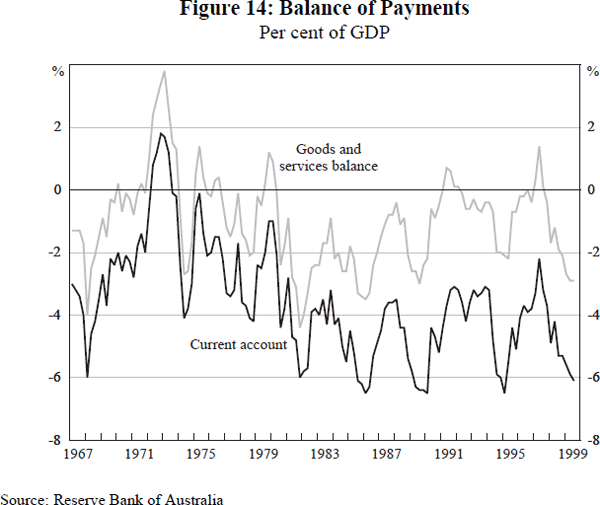
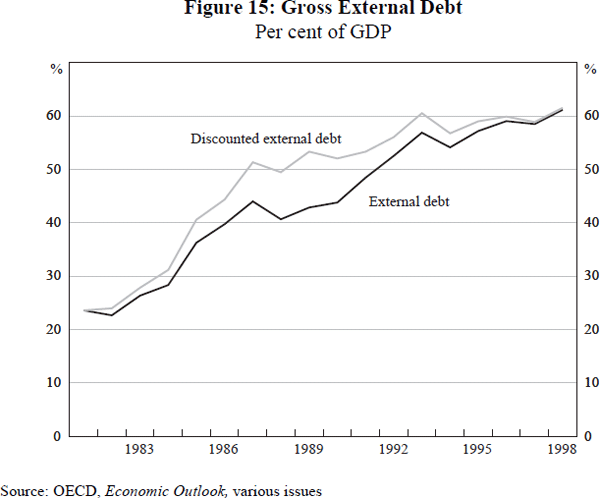
5.1 Sustainability
As noted earlier, thinking in Australia about the current account deficit has moved from one of concern in the 1970s and 1980s to something closer to benign neglect in the 1990s. In a sense this is how it should be, for there is nothing necessarily unsustainable about such a deficit. Global capital market integration facilitates the separation of national savings decisions from national investment decisions, an idea that underlies the intertemporal approach to the current account (see Frenkel and Razin (1987)). If a country has excellent unexploited investment opportunities, it makes economic sense for those opportunities to be exploited through accessing foreign investment funds, rather than depressing domestic consumption to finance it through domestic savings. This would lead to a balance of trade deficit and capital inflows initially, followed by an improvement in the trade balance coupled with a deteriorating investment income component as the profits on the investment are remitted abroad.
Moreover, there is no reason why a current account deficit should ever need to disappear. If demographics, the structure of domestic and foreign pension schemes, etc, warrant it, then it may be optimal for foreigners always to have a net claim on part of the country's output. If nominal GDP is growing this requires an ongoing current account deficit (capital inflow) to maintain the share of net foreign liabilities relative to GDP. Thus if nominal GDP is growing at 5 per cent per annum (composed, say, of 2 per cent inflation and 3 per cent real growth) and net indebtedness to foreigners (debt and equity) is 50 per cent, the country would need to maintain a current account deficit of 2½ per cent of GDP indefinitely.
As evidence that there is nothing per se unusual about the Australian current account deficit, we might simply cite the experience over the years 1960–90 of: Denmark, with a current account deficit averaging 2.7 per cent of GDP and in surplus only in 1963 and 1990; Greece with a current account deficit averaging 2.6 per cent of GDP and in deficit every year; and Ireland with a current account deficit averaging 4.3 per cent of GDP and in surplus in only 1967. We might sensibly, though, ask whether the upward trend in the external debt to GDP ratio portrayed in Figure 15 indicates unsustainability in the external position. On the one hand the data could indicate explosive behaviour of this ratio, but is also consistent with both an asymptotic approach to a new higher steady-state or a temporary build-up that will subsequently be unwound.
The literature provides a number or formal tests for unsustainable debt dynamics. One such test is due to David Wilcox (1989) that is obtained as follows. First write the debt accumulation equation in intensive form as:

where bt is the end of period debt to GDP ratio,  is the rate of interest
on foreign borrowing in period t, gt is the growth
rate of GDP in period t and zt is the surplus
on goods and services plus any transfer income such as foreign aid in period
t, expressed as a fraction of GDP. Now define the discount factor,
qt, recursively by:
is the rate of interest
on foreign borrowing in period t, gt is the growth
rate of GDP in period t and zt is the surplus
on goods and services plus any transfer income such as foreign aid in period
t, expressed as a fraction of GDP. Now define the discount factor,
qt, recursively by:

with q0 = 1 for some base period 0. Sustainability then requires that the transversality condition Limt→∞E0[qtbt] = 0 is satisfied. Defining ft≡qtbt and xt≡qtzt we may then re-write the debt accumulation equation as:

and the transversality condition becomes Limt→∞E0[ft] = 0. Thus a test of sustainability can be executed by examining the stochastic properties of the discounted debt to GDP ratio, ft; in particular it should be stationary with zero drift.
To apply this to the data in Figure 15, we calculate  as the ratio of net foreign investment payments
in period t to the value of net liabilities at the beginning of the
period, and then discount the debt to GDP ratio back to 1981, the earliest
year for which we have data. The resulting series is also plotted in Figure
15. This discounted series rises above the actual series in the first part
of the period because the growth-corrected interest rate is negative for the
early years of the sample. A simple Dickey-Fuller test on the discounted debt
series
yields (t-statistics in parenthesis):
as the ratio of net foreign investment payments
in period t to the value of net liabilities at the beginning of the
period, and then discount the debt to GDP ratio back to 1981, the earliest
year for which we have data. The resulting series is also plotted in Figure
15. This discounted series rises above the actual series in the first part
of the period because the growth-corrected interest rate is negative for the
early years of the sample. A simple Dickey-Fuller test on the discounted debt
series
yields (t-statistics in parenthesis):

This gives only weak evidence that ft might be stationary, and moreover the intercept is significant, suggesting unsustainability. Of course this result is not terribly surprising given the particular features of the (rather short) sample. Nevertheless it suggests that at some stage in the future a fundamental improvement in the balance of trade on goods and services is required. The interesting question is whether this will happen through an increase in future supply (which might well be the case if the productivity revival continues) or through a reduction in domestic demand.
5.2 National savings
In order to investigate this further we need to go behind the current account to see what has been happening to savings and investment. Figure 16 plots the ratio of national savings and national investment to gross national income (rather than gross domestic product as is usually the case, although the picture is similar) since the beginning of the 1960s. Averaged over the cycle, the investment ratio remains remarkably constant at around 22 per cent of GDP. All of the action in the balance of payments instead originates in the behaviour of the savings ratio, which falls in the mid 1970s, recovering only somewhat in the 1990s.
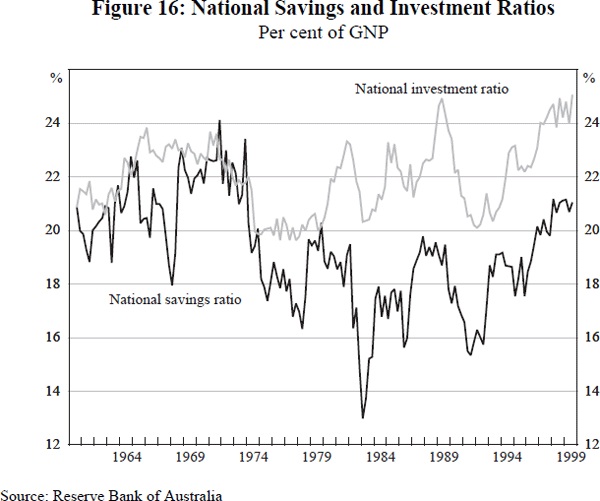
Viewed from the standpoint of optimal consumption theory this behaviour is hard to rationalise. Consider for the moment the standard benchmark one-good open economy subject to perfect international capital mobility and peopled by infinitely lived households (or equivalently Barrovian dynasties) who can choose to either consume or save. The latter can be in the form of either fixed domestic capital which will be combined with labour to produce domestic output next period or invested in foreign assets which offer a given rate of return. For simplicity of exposition take this as a constant, r. Assume labour is supplied inelastically and markets clear. In this set-up the investment allocation decision (between domestic and foreign capital) can be separated from the overall savings decision. The optimal investment allocation decision obviously requires accumulating domestic fixed capital up to the point where the marginal product of capital net of depreciation equals the exogenously given interest rate. Assuming homothetic preferences the optimal savings plan then makes consumption (here identified with the sum of public and private consumption) proportional to the sum of human and non-human wealth as in the standard permanent income hypothesis:

where Ct is consumption in period t,
Wt is the sum of holdings of domestic capital and foreign
assets and Yl,t is labour income (with units of labour
supplied valued at the prevailing marginal product of labour). Total national
income is then Yt = rWt+Yl,t.
Define ‘saving’ as  (which equals conventional
measures when γ=1). Then, as shown by Campbell (1987), Equation
(8) can be re-written as a statement about saving:
(which equals conventional
measures when γ=1). Then, as shown by Campbell (1987), Equation
(8) can be re-written as a statement about saving:

Hence savings should be a predictor of the present value of future expected declines in the human component of income. This is sometimes known as the ‘saving for a rainy day’ hypothesis.
Unlike Campbell we are not interested in testing the veracity or otherwise of the permanent income hypothesis, but rather in using it as a benchmark to evaluate Australian savings behaviour. In particular we want to see whether national savings behaviour can be justified by the subsequent evolution of labour income. To do this we estimate a bivariate vector autoregression in the change in labour income and savings, both of which should be stationary according to the model. Rather than work with the levels of savings and income, it is more natural for our purposes to work with the logarithms of consumption, labour income and national income. In the attendant table lower-case letters are used to denote logarithms of the respective variables. Also, rather than use employee compensation as our measure of labour income, we choose instead to work with gross domestic product. We do this because the observed wage will differ from the marginal product of labour if wage contracts include an element of insurance as in implicit contract theory. However, if the production function is Cobb-Douglas, a natural benchmark, then labour income, correctly measured, will be a constant fraction of gross domestic product. This has the added advantage of giving us a slightly longer sample (1960:Q1–1999:Q3) to work with. Finally the model includes zero-one dummies for the periods 1974:Q1–1990:Q4 and 1991:Q1–1999:Q3 to control for the productivity slowdown of the 1970s and the productivity revival of the 1990s. These will be a key focus of interest in the analysis.
Preliminary analysis of the co-integration properties of yt and ct suggest they are indeed co-integrated with a co-integration vector (1,−1) so that yt−ct is stationary. In fact only very limited dynamics are required in the model, the final version of which is given in Table 3, with lagged savings, yt-1− ct-1, being the only regression variable that is significant once the constants and dummies are included. The regression equation for the rate of growth of output has the ‘saving for a rainy day’ feature in that high levels of savings anticipate low levels of future output growth.
| Dependent variable | ||
|---|---|---|
| Δyl,t | yt – ct | |
| Constant | 0.0375 (3.09) |
0.0596 (5.00) |
| Dummy 1974:Q1–1990:Q4 | −0.0091 (3.11) |
−0.0114 (3.93) |
| Dummy 1991:Q1–1999:Q3 | −0.0066 (2.17) |
−0.0071 (2.33) |
| yt-1 – ct-1 | −0.106 (2.10) |
0.751 (15.08) |
| Test on exclusion of Δyl,t-1, Δyl,t-2, yt-2 – ct-2(F(3,147)) |
0.50 | 1.01 |
| Standard error | 0.0088 | 0.0118 |
| Box-Pierce (χ2(36)) | 43.9 | 36.1 |
| Note: t-statistics in parentheses. | ||
More interesting for our purposes are the constants in the respective equations. Solving the two equations for the implied steady-state values of savings and output growth gives:

At low frequencies the savings rate thus moves with, rather than against, the rate of growth of trend output; i.e. rather than saving for a rainy day (or rather decade) Australians spend to cheer themselves up! In fact the parameter estimates of the constants and dummies suggest that the savings function can be more parsimoniously written as a function of just output growth rather than the constants and dummies. When we replace the dummies by current output growth and estimate by instrumental variables using the constant, dummies and lagged savings as instruments for output growth we get:

Importantly the Sargan test of the over-identifying restrictions is quite insignificant, indicating that this is a legitimate restriction. Hence the equilibrium national savings rate appears to be increasing, rather than decreasing in the growth rate.
Whilst the behaviour of the national savings rate departs from our optimal consumption benchmark, the fact that the savings rate appears to be increasing, rather than decreasing, in the growth rate suggests that if the recent high TFP growth rates are sustained, then the external debt to GNP ratio will tend to stabilise, not only because of higher output, but also because of higher savings. Per contra if the rate of TFP growth were to return to the rates seen in the 1970s and 1980s, one would expect the explosive growth of the external debt to GNP ratio to resume, absent deliberate policy intervention to correct the problem.
5.3 Household savings
Of course, looking at the national savings rate conceals what is going on beneath, within individual sectors. As noted in Section 2, the public sector deficit has generally been well behaved, so the current account deficit is not the counterpart of a profligate fiscal policy. Likewise the business sector savings rate shows a slight upward trend, and like the public sector savings rate is strongly pro-cyclical. Rather, most of the action occurs in the household sector, where there is a clear downward trend in both Australia and the US. Figure 17 plots the household savings rates for Australia, the UK and the US over the last two decades; the data for Australia and the US are net of capital consumption, whilst the figures for the UK refer to gross savings rates. This makes it clear that the deterioration of the current account in the 1980s was associated with a decline in household savings, but this has been offset by the increase in business and public sector savings during the 1990s. The sharp deterioration in the UK savings rate associated with the Lawson Boom is clearly visible, and comparable in absolute size to the fall in the Australian savings ratio over the last four years. Indeed both show sharper movements than are seen in the US during the long boom of the last decade.
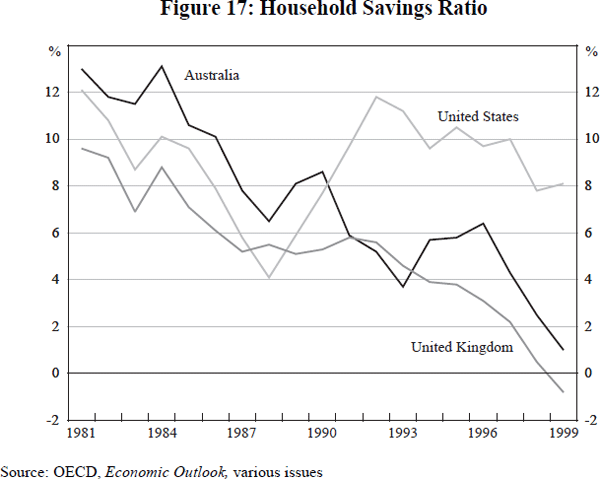
An inverse relationship between household savings on the one hand and public and business savings on the other is natural and could arise in two ways. First, if Ricardian Equivalence holds (as is implicitly the case in the model of Section 5.2), then households realise that higher levels of public or business savings now will ultimately show up as higher disposable household income in the future. In this story it is public and business savings decisions that are driving the decline in household savings. Alternatively, household savings may instead be driving public and business savings. This will be the case, for instance, in standard Keynesian models where higher levels of consumer demand generate higher incomes, higher tax revenues for government, and higher profits for business. Under this explanation the low levels of savings by Australian households in recent years would then be due to a mix of optimistic expectations of future income growth, increasing financial and real wealth (also driven by optimism about the future), and an increased ability to borrow.
Now under the Ricardian Equivalence view the sectoral decomposition of savings is of little interest. However, under the alternative hypothesis that household savings decisions are the driver, there is potentially more at stake. My own view is that this alternative explanation is a more plausible explanation of the facts, and I shall therefore treat it as the maintained hypothesis in what follows. The question, then, is should policy-makers be worried about the present low level of household savings, and with it the current account deficit?
The idea that governments should adopt a policy of benign neglect to a current account deficit if it is the consequence of private sector decisions, rather than the consequence of unsustainable fiscal plans[15], figured prominently in UK debates at the end of the 1980s where it was referred to as the ‘Lawson Doctrine’ after Nigel Lawson, the Chancellor of the Exchequer (sometimes also the ‘Burns Doctrine’ after the then Chief Economic Adviser, Sir Terry Burns). Gruen and Stevens (this volume) refer to this in the Australian context as the ‘consenting adults’ approach.
What are the limitations to the thesis? First, excessive borrowing may raise the risk premium on debt. To the extent that the risk premium reflects the indebtedness of the borrower and thus the riskiness of the loan, this is not a problem; only if there is an externality so that more borrowing by one individual raises the risk premium for other borrowers should the government be concerned. Moreover, as Gruen and Stevens argue, the evidence that high levels of Australian foreign borrowing have significantly affected risk premia is anyway relatively weak.
Second, if this borrowing is in foreign currency, it leaves the country vulnerable to a strongly contractionary wealth effect should the exchange rate depreciate sharply. This was, of course, an important factor in the Asian Crisis. However, most of the increase in Australian foreign indebtedness has been in the form of equity rather than debt, so it does not seem to be particularly vulnerable, and indeed has already weathered a 25 per cent depreciation against the US$ during 1997/98 without mishap.
Third, if private savings behaviour is based on overly optimistic expectations of the future, then there must be a correction when households wake up to the fact that they are overly indebted. One potential indicator of optimistic household expectations is likely to be asset prices, particularly of houses, as the demand for housing is likely to be related to households' estimate of their permanent income. The fact that over the last four years real house prices in Australia have grown at an average annual rate of 6½ per cent per year is indicative in this regard.
Such a scenario does seem to be a possibility if TFP growth does indeed moderate in the future. In that case household savings could rise quite sharply. This would be desirable from a medium-term perspective as it would help to bring about the increase in national savings that Section 5.2 argued was necessary. However, such a correction does raise problems of macroeconomic management, as it will also tend to produce a fall in activity in the short run. The appropriate response is obviously to lower interest rates to stimulate investment and to raise competitiveness through a depreciation of the currency. The depth of any short-term recession can also be ameliorated provided the automatic fiscal stabilisers are free to operate.
Fortunately, the degree of (over-)optimism does not seem to be as pronounced as in the UK at the end of the 1980s. For instance the rise in Australian house prices is still quite mild compared to the explosion seen in the UK during the last four years of the Lawson Boom, when real house prices grew at an average annual rate of 14 per cent. Moreover, when the slowdown in UK consumption growth occurred in 1990–91, the Government was unable to relax monetary policy to counteract it on account of membership of the Exchange Rate Mechanism and also felt constrained on fiscal policy because of the rising budget deficit. Australian policy makers, by contrast, seem well placed to respond to any slowdown in consumption by relaxing both monetary and fiscal policy. But it does suggest that the Australian government should resist the temptation to spend the current surpluses.
6. Conclusions
Australia's ‘miraculous’ performance in the last decade seems to be down to a serendipitous mix of good luck, judicious macroeconomic management and effective structural reforms. However, economic miracles have a tendency to turn sour just when everyone is celebrating them. Whilst the high recent rates of productivity growth may continue into the future, it would be unwise to bank on it. In that case Australia may experience something like the UK at the end of the 1980s, namely a downturn precipitated by a rise in savings. Fortunately, unlike the UK, Australian policy-makers seem to be in a good position to weather the storm.
Appendix A – Data
| Unemployment rates | Standardised unemployment rates. Source: OECD |
|---|---|
| Replacement ratio | Gross benefits for single person under 50 as per cent of relevant wage. Source: Layard et al (1991), Table 9, Chapter 9 |
| Benefit duration | Duration of eligibility to some form of benefit (months). Source: Layard et al (1991), Table 9, Chapter 9 |
| Labour market programmes | Spending on ALMPs as per cent of output/head. Source: Layard et al (1991), Table 9, Chapter 9 |
| Union power | UNCD-EMCD(a) Source: Layard et al (1991), Table 9, Chapter 9 |
| Union-employer coordination | UNCD+EMCD(a) Source: Layard et al (1991), Table 9, Chapter 9 |
| Wage flexibility | LWC+IW+SWC(b) Source: Layard et al (1991), Table 11, Chapter 9 |
| Employee protection | Overall summary indicator of strictness of employment protection
legislation (Version 2). Source: OECD (1999), Table 2.5 |
| (a) UNCD = Extent of inter-union co-ordination, both formal and informal,
in the process of wage bargaining. EMCD = Extent of inter-firm co-ordination, both formal and informal, in the process of wage bargaining. (b) LWC = Length of wage contracts. IW = Indexation in wage contracts. SWC = Synchronisation of wage contracts. |
|
Footnotes
The data are for the EU15 and thus include the UK. However the weight of the UK in overall EU15 GNP etc is only 15 per cent, so the picture would be quite similar for the EU excluding the UK. However, when the text refers to the EU, I shall generally mean the EU excluding the UK. [1]
In the counterfactual the nominal interest rate is actually some 2 percentage points higher, i.e. it corresponds to an increase in actual interest rates of about 1½ percentage points rather than the ½ a percentage point cut that occurred. This episode is, incidentally, an excellent illustration of the danger in targeting an MCI, as the appropriate weighting between the components should depend on the nature of the shocks hitting the economy. Indeed the only occasion weighting interest rates and exchange rates together into an MCI makes much sense is when exchange rate shocks are entirely exogenous, e.g. driven by bubbles. [2]
Both the RBA's ‘2–3 per cent over the cycle’ and the UK's 2½ per cent target coupled with the explicit recognition that it will not be met continuously because of shocks seem to satisfy this criterion. [3]
Unless one assumes implausibly that Australian workers and firms were expecting even lower inflation than occurred. [4]
I am assuming that unemployment benefits, etc, are raised in line with wages so that replacement ratios remain unchanged. [5]
A nice recent contribution to this literature is provided by Tyers and Yang (1999) who show how fragile the basic Stolper-Samuelson result is to changing the product market structure to allow trade in differentiated goods. [6]
I use the logarithm because many models suggest that the mark-up of wages over the outside option is convex in the unemployment rate. Statistical tests also suggests this specification is preferable to using the level of the unemployment rate in the model. [7]
In case the negative estimated value of α for Switzerland seems odd, remember that the dependent variable is the logarithm of the unemployment rate, and that Swiss unemployment rates were below 1 per cent for much for this period. [8]
By ‘well’ I mean in terms of generating low unemployment. Of course this is not the same as maximizing welfare. [9]
This outstanding performance would probably be even more marked if the most recent couple of years were included. However, the introduction of the European System of Accounts (ESA) have led the OECD to temporarily suspend publication of the data. [10]
I have also included the constituent parts separately; the gist of the results is unchanged. [11]
Moreover, competitive markets may not, on their own, be enough. Dowrick (1998) points out that the New Zealand productivity performance in recent years has been distinctly underwhelming, despite undergoing major pro-competitive reforms over the last decade or so. [12]
Two other explanations were also prevalent during the early stages of the productivity upturn, namely labour hoarding and mismeasurement of capital due to premature scrapping. Neither fitted the subsequent facts; see Bean and Symons (1989). [13]
The privatisation program did not really get underway until the latter part of the Mrs Thatcher's premiership and thus cannot be the explanation for the pick-up in productivity growth which began early in the decade. [14]
In which case they need, of course, to address the underlying cause of the problem! [15]
References
Alogoskoufis G, C Bean, G Bertola, D Cohen, JJ Dolado and G Saint-Paul (1995), Unemployment: Choices for Europe, Centre for Economic Policy Research, London.
Aghion P and P Howitt (1994), ‘Growth and Unemployment’, Review of Economic Studies, 61, pp 477–494.
Bean CR (1994a), ‘European Unemployment: A Survey’, Journal of Economic Literature, 32(2), pp 573–619.
Bean CR (1994b), ‘European Unemployment: A Retrospective’, European Economic Review, 38, pp 523–534.
Bean CR and JSV Symons (1989), ‘Ten Years of Mrs. T.’, NBER Macroeconomics Annual, 4, pp 13–61.
Bentolila S and G Bertola (1990), ‘Firing Costs and Labour Demand: How Bad is Eurosclerosis’, Review of Economic Studies, 57(3), pp 381–402.
Blanchard OJ and J Wolfers (2000), ‘The Role of Shocks and Institutions in the Rise in European Unemployment: The Aggregate Evidence’, Economic Journal, 110, pp C1–C33.
Brynjolfsson E and LM Hitt (1997), ‘Information Technology and Internal Firm Organisation: An Exploratory Analysis’, mimeo.
Calmfors L (1994), ‘Active Labour Market Policy and Unemployment: A Framework for the Analysis of Crucial Design Features’, OECD Economic Studies, 22, pp 7–47.
Calmfors L and J Driffill (1988), ‘Bargaining Structure, Corporatism and Macroeconomic Performance’, Economic Policy, 6, pp 14–61.
Campbell J (1987), ‘Does Saving Anticipate Declining Labour Income? An Alternative Test of the Permanent Income Hypothesis’, Econometrica, 55, pp 1249–1273.
Coe DT and E Helpman (1995), ‘International R&D Spillovers’, European Economic Review, 39(5), pp 859–887.
Corden M (1991), ‘Does the Current Account Matter? The Old View and the New’, Economic Papers, 10(3), pp 1–19.
Daveri F and G Tabellini (2000), ‘Unemployment, Growth and Taxation in Industrial Countries’, Economic Policy, 30, pp 47–88.
Dowrick S (1998), ‘Explaining the Pick-Up in Australian Productivity Performance’, in Microeconomic Reform and Productivity Growth, Productivity Commission and ANU, Working Proceedings Paper 5, AusInfo, Canberra, pp 123–143.
The Economist (2000), ‘Australian Currency: Surfing Dollar’, 29 April.
Frenkel JA and A Razin (1987), Fiscal Policies and the World Economy, MIT Press, Cambridge, Mass.
Friedman M (1968), ‘The Role of Monetary Policy’, American Economic Review, 58(1), pp 1–17.
Gordon R (1999), ‘Has the New Economy Rendered the Productivity Slowdown Obsolete?’, Northwestern University, mimeo.
Greenspan A (1996), ‘Remarks before the National Governors' Association’, February.
Greenwood J (1997), The Third Industrial Revolution, American Enterprise Institute, Washington DC.
Jackson Committee (1975), ‘Policies for Development of Manufacturing Industry: Volume I’, Report to the Prime Minister by the Committee to Advise on Policies for Manufacturing Industry, Green Paper, Australian Government Publishing Service, Canberra.
Jorgenson DW and K Stiroh (1995), ‘Computers and Growth’, Economics of Innovation and New Technology, 3, pp 295–316.
King M (1990), ‘Discussion of Muellbauer and Murphy’, Economic Policy, 11, pp 383–387.
Krugman PR (1994), ‘Past and Prospective Causes of High Unemployment’, in Reducing Unemployment: Current Issues and Policy Options, Symposium sponsored by the Federal Reserve Bank of Kansas City, Jackson Hole, Wyoming, August 25–27, pp 49–80.
Krugman PR (1998), ‘It's Baaack: Japan's Slump and the Return of the Liquidity Trap’, Brookings Papers on Economic Activity, 2, pp 137–205.
Layard PRG and SJ Nickell (1986), ‘Unemployment in Britain’, Economica, Supplement, 53, pp S121–S169.
Layard PRG and SJ Nickell (1999), ‘Labour Market Institutions and Economic Performance’, in Ashenfelter O and D Card (eds), Handbook of Labor Economics Vol 3C, Elsevier, Amsterdam.
Layard PRG, SJ Nickell and R Jackman (1991), Unemployment: Macroeconomic Performance and the Labour Market, Oxford University Press, Oxford.
Lindbeck A and DJ Snower (1989), The Insider-Outsider Theory of Employment and Unemployment, MIT Press, Cambridge, Mass.
Lowe P (ed) (1997), Monetary Policy and Inflation Targeting, Proceedings of a Conference, Reserve Bank of Australia, Sydney.
Mishkin FS (1997), ‘Strategies for Controlling Inflation’, in P Lowe (ed), Monetary Policy and Inflation Targeting, Proceedings of a Conference, Reserve Bank of Australia, Sydney, pp 7–38.
Muellbauer J and A Murphy (1990), ‘Is the UK Balance of Payments Sustainable?’, Economic Policy, 11, pp 347–383.
Nickell SJ (1996), ‘Competition and Corporate Performance’, Journal of Political Economy, 104(4), pp 724–746.
Nickell SJ (1998), ‘Unemployment: Questions and Some Answers’, Economic Journal, 108, pp 802–816.
Nicoletti G, S Scarpetta and O Boylaud (1999), ‘Summary Indicators of Product Market Regulation with an Extension to Employment Protection Legislation’, OECD Economics Department Working Papers, No 226.
OECD (1999), ‘Employment Protection and Labour Market Performance’, Employment Outlook, Paris, pp 49–132.
OECD (2000), Economic Surveys: Australia, Paris.
Oliner SD and DE Sichel (1994), ‘Computers and Output Growth Revisited: How Big is the Puzzle?’, Brookings Papers on Economic Activity, 2, pp 273–334.
Phelps ES (1994), Structural Slumps: the modern equilibrium theory of unemployment, interest and assets, Harvard University Press, Cambridge, Mass.
Pissarides CA (1990), Equilibrium Unemployment Theory, Basil Blackwell, Oxford.
Pitchford JD (1989), ‘A Sceptical View of Australia's Current Account and Debt Problem’, The Australian Economic Review, 86, pp 5–14.
Pitchford JD (1990), Australia's Foreign Debt: Myths and Realities, Allen and Unwin, Sydney.
Pohjola M (1998), ‘Information Technology and Economic Development: An Introduction to the Research Issues’, World Institute for Deveolpment Economics Research, Helsinki, mimeo.
Productivity Commission (1999), Microeconomic Reforms and Australian Productivity: Exploring the Links, Commission Research Paper, AusInfo, Canberra.
Sichel DE (1997), The Computer Revolution: An Economic Perspective, Brookings Institution Press, Washington DC.
Solow R (1987), ‘We'd Better Watch Out’, New York Times Review of Books, July 12.
Tyers R and Y Yang (1999), ‘European Unemployment and the Asian Emergence: Generalising the Elemental Trade Model’, Australian National University, mimeo.
Wadhwani SB (2000), ‘The Impact of the Internet on UK Inflation’, Bank of England Quarterly Bulletin, 40(2), pp 184–198.
Wilcox DW (1989), ‘The Sustainability of Government Deficits: Implications of the Present-Value Borrowing Constraint’, Journal of Money, Credit and Banking, 21(3), pp 291–306.
Wood A (1994), North-South Trade, Employment and Inequality, Clarendon Press, Oxford.